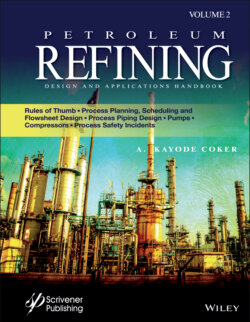Читать книгу Petroleum Refining Design and Applications Handbook - A. Kayode Coker - Страница 20
TOWERS
Оглавление1 1. Distillation usually is the most economical method of separating liquids, superior to extraction, absorption, crystallization, or others.
2 2. For ideal mixtures, relative volatility is the ratio of vapor pressure, α12 = P2/P1.
3 3. Tower operating pressure is most often determined by the temperature of the available condensing medium, 38–50°C (100–120°F) if cooling water, or by the maximum allowable reboiler temperature, 10.34 barg (150 psig) steam, 186°C (366° F) to avoid chemical decomposition/degradation.
4 4. Sequencing of columns for separating multicomponent mixtures:a. Perform the easiest separation first, that is, the one least demanding of trays and reflux, and leave the most difficult to the last.b. When neither relative volatility nor feed concentration vary widely, remove the components one by one as overhead products.c. When the adjacent ordered components in the feed vary widely in relative volatility, sequence the splits in the order of decreasing volatility.d. And when the concentrations in the feed vary widely but the relative volatilities do not, remove the components in the order of decreasing concentration in the feed.
5 5. The economically optimum reflux ratio is about 1.2–1.5 times the minimum reflux ratio Rm.
6 6. The economically optimum number of theoretical trays is near twice the minimum value Nm.
7 7. The minimum number of trays is found with the Fenske–Underwood equation:
8 8. Minimum reflux for binary or pseudobinary mixtures is given by the following when separation is essentially complete (xD ≌ 1) and D/F is the ratio of overhead products to feed rate:
9 9. A safety factor of 10% of the number of trays calculated by the best means is advisable.
10 10. Reflux pumps are made at least 10% oversize.
11 11. The optimum value of the Kremser—Brown absorption factor A = (L/VK) is in the range 1.25–2.0.
12 12. Reflux drums usually are horizontal, with a liquid holdup of 5 min half-full. A takeoff pot for a second liquid phase, such as water in hydrocarbon systems, is sized for a linear velocity of that phase of 0.15 m/s (0.5 ft/s) minimum diameter of 406.4 mm (16 in.).
13 13. For towers about 914 mm (3 ft) diameter, add 1219 mm (4 ft) at the top for vapor disengagement and 1829 mm (6 ft) at the bottom for liquid level and reboiler return.
14 14. Limit the tower height to about 53 m (175 ft) maximum because of wind load and foundation considerations. An additional criterion is that L/D be less than 30 (20 < L/D < 30 often will require special design).
